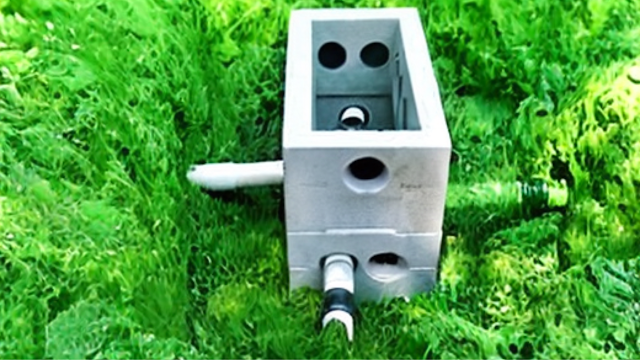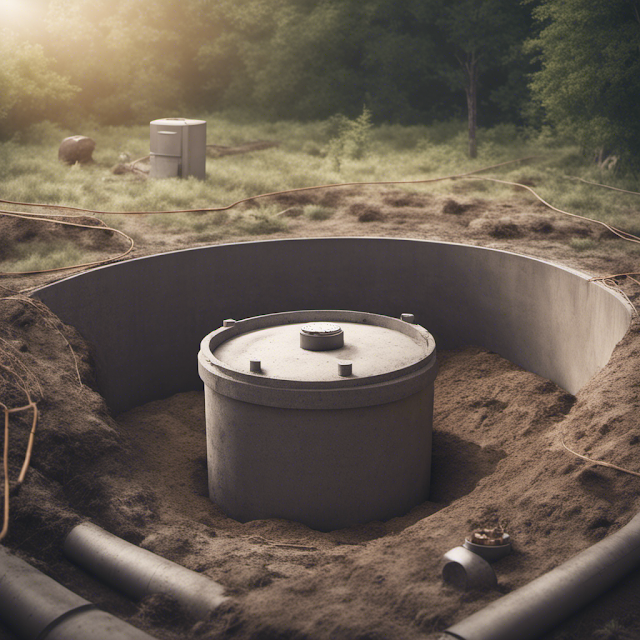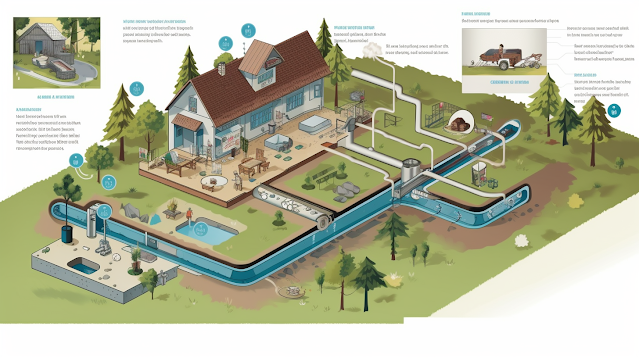Managing Malfunctioning Septic Systems: Tips for Emergencies
 |
| Managing Malfunctioning Septic Systems: Tips for Emergencies |
In emergencies, managing malfunctioning septic systems is crucial to prevent contamination of drinking water. Signs of a malfunction include slow draining sinks, overflowing floor drains, and visible sewage outside the home.
The Environmental Protection Agency (EPA) recommends preparing the septic system beforehand by sealing manholes and inspection ports, ensuring the tank is half full, and turning off the pump in flood-prone areas.
During an emergency, water usage should be limited, and contact with sewage-containing water should be avoided.
Afterward, it is important to get the septic system professionally inspected and serviced if damage is suspected.
Key Takeaways
- Seal manhole and inspection ports to prevent excess water from entering the septic tank
- Limit water usage during emergencies to avoid overwhelming the system
- Avoid contact with standing water that may contain sewage to prevent contamination
- Get the septic system professionally inspected and serviced after an emergency to address any damage or issues
Signs of a Malfunctioning Septic System
The signs of a malfunctioning septic system include slow draining sinks, slow draining toilets, overflowing floor drains, and visible sewage outside the home. These symptoms indicate that there may be a problem with the septic system, such as a clog or a full tank.
Common causes of septic system malfunctions include excessive water usage, flushing non-biodegradable items down the toilet, and lack of regular maintenance.
To prevent septic system failures, it is important to be mindful of what goes down the drains and toilets. Avoid flushing items like diapers, wipes, and grease, as they can clog the system.
Additionally, it is recommended to have the septic system inspected and pumped regularly to ensure proper functioning. Taking these preventive measures can help avoid costly repairs and protect the health of your septic system.
Preparing Your Septic System Before an Emergency
Before an emergency, homeowners should take several important steps to prepare their septic tank:
- Seal manhole and inspection ports to keep excess water out of the septic tank. This is crucial for septic system maintenance and preparation.
- By sealing these ports, homeowners can prevent water from entering the tank and potentially causing damage or overflow during an emergency situation.
In addition to sealing the ports, there are other key measures to take:
- Ensure that the septic tank is at least half full before an emergency occurs. This helps to prevent collapse or floating of the tank.
- Homeowners should turn off the pump at the circuit box if the area is prone to flooding.
- Waterproof all electrical connections to avoid damage.
Actions to Take During an Emergency
During an emergency, homeowners should limit water usage by reducing toilet flushing, dishwashing, laundry, and showering to help prevent further strain on the septic system. This is an important step in water conservation and minimizing the risk of contaminating groundwater. Taking action during an emergency can make a significant difference in the functionality of a malfunctioning septic system.
Here are four key actions to take:
Avoid contact with standing water that may contain sewage. This can help prevent the spread of harmful bacteria and viruses.
Be aware of the increased risk of contamination for drinking water wells during severe flooding. It is crucial to protect your water source.
Follow recommendations for protecting yourself and your family during floods. This includes practicing good hygiene and using sanitation solutions.
Seek professional inspection and servicing of the septic system if damage is suspected. This will ensure that any issues are addressed promptly and effectively.
Precautions After an Emergency
After an emergency, homeowners should take precautions to prevent further damage and ensure the safety of their septic system. They should not pump out the septic tank more than halfway to prevent floating, and if damage is suspected, they should get the septic system professionally inspected and serviced. Flooding can lead to floodwater contamination, which poses a serious health risk if it enters the septic system.
Homeowners should be aware that floodwater may contain sewage and should avoid contact with it. They should also refrain from drinking well water until it has been determined to be safe. Additionally, it is important to avoid contact with septic system electrical devices until they are dry and clean. By following these precautions and getting the septic system inspected and serviced by professionals, homeowners can ensure the proper functioning and maintenance of their septic system after an emergency.
Limiting Water Usage During an Emergency
Homeowners can effectively reduce water usage during an emergency by minimizing toilet flushing, dishwashing, laundry, and showering. This not only helps conserve water but also prevents contamination of drinking water sources.
To limit water usage, individuals can take the following steps:
Use the toilet sparingly: Flush only when necessary to minimize water consumption.
Opt for handwashing: Consider washing dishes by hand instead of using the dishwasher to save water.
Conserve laundry: Limit the number of loads and use the appropriate water level settings.
Take shorter showers: Reduce shower time to minimize water usage.
Increased Risk of Contamination for Drinking Water Wells
The risk of contamination for drinking water wells increases during severe flooding, posing potential health hazards to individuals.
Drinking water contamination is a major concern during these situations, as floodwaters can carry pollutants and pathogens that can infiltrate groundwater sources. Proper septic system maintenance is crucial in preventing this contamination.
Malfunctioning septic systems can release untreated sewage into the environment, which can then seep into nearby wells. To mitigate this risk, individuals should ensure that their septic systems are properly maintained and inspected regularly. This includes sealing manholes and inspection ports, turning off pumps in flood-prone areas, and waterproofing electrical connections.
Additionally, it is important to limit water usage during emergencies to prevent overwhelming the septic system. By taking these precautions, individuals can help protect their drinking water from contamination during severe flooding.
Sanitation Solutions During Emergency Response
During an emergency, individuals should prioritize limiting water usage and avoiding contact with standing water that may contain sewage. This is crucial for maintaining sanitation and preventing the spread of diseases.
Here are four important sanitation measures to consider during emergency response:
Reduce water usage: By minimizing toilet flushing, dishwashing, laundry, and showering, individuals can conserve water and avoid overloading the septic system.
Avoid contact with standing water: Standing water can be contaminated with sewage, which poses health risks. It is important to stay away from areas with standing water and ensure proper hygiene practices, such as washing hands with soap and clean water.
Ensure well water safety: After an emergency, it is essential to have the well water tested before consuming it. Contamination from flooding can affect the quality of well water, so it is important to take precautions.
Seek professional inspection and servicing: If there is any suspicion of septic system damage, it is advisable to have it professionally inspected and serviced. This can help prevent further issues and ensure that the septic system is functioning properly.
Additional Resources for Managing Malfunctioning Septic Systems
Individuals can access a variety of additional resources to aid in the management of septic systems experiencing malfunctions. These additional resources provide valuable information and guidance on septic system maintenance.
For example, the Environmental Protection Agency (EPA) offers resources such as 'First Aid for a Flooded Septic System' and 'What to Do After a Flood - Septic Systems.' These resources provide step-by-step instructions on how to properly handle and address issues with septic systems after a flood or emergency.
Additionally, the EPA's 'Septic Systems - Tools and Resources' provides a wealth of information on septic system maintenance, including tips on how to prevent contamination of drinking water.
Other resources, such as those provided by Cornell University and FEMA, offer further guidance and tools for managing malfunctioning septic systems.
Professional Inspection and Servicing After an Emergency
After an emergency, it is important to have a professional inspect and service the septic system if damage is suspected. This is crucial to ensure that the system is functioning properly and to prevent any further issues. Here are four reasons why a professional inspection and servicing is necessary:
Identification of damage: A professional inspection can help identify any damage or issues that may have occurred during the emergency. This can include cracks, leaks, or other forms of damage that may not be visible to the naked eye.
Repair and maintenance: Once the damage is identified, a professional can provide the necessary repairs and maintenance to restore the septic system to its optimal condition. This can help prevent future problems and extend the lifespan of the system.
Ensure proper functionality: A professional inspection and servicing can ensure that the septic system is functioning properly. This includes checking for any blockages, ensuring proper drainage, and assessing the overall performance of the system.
Peace of mind: By having a professional inspect and service the septic system, homeowners can have peace of mind knowing that their system is in good hands. This can alleviate any concerns or worries about the functionality and safety of the system.
Frequently Asked Questions
How Can I Determine if My Septic System Is Malfunctioning?
Signs of a malfunctioning septic system can include slow draining sinks, toilets, and overflowing floor drains. Regular inspection is crucial to identify any issues, such as visible sewage outside the home, and prevent contamination of drinking water.
Are There Any Temporary Solutions to Manage a Malfunctioning Septic System During an Emergency?
Temporary solutions to manage a malfunctioning septic system during an emergency include reducing water usage and avoiding contact with standing water. These precautions help minimize the risk of contamination and should be followed until professional inspection and servicing can occur.
Can a Malfunctioning Septic System Pose Health Risks to Me and My Family?
A malfunctioning septic system can pose health risks to individuals and their families. It is important to prioritize septic system maintenance to prevent contamination of drinking water and potential exposure to sewage.
What Should I Do if I Suspect Damage to My Septic System After an Emergency?
If suspecting damage to a septic system after an emergency, it is crucial to take immediate action. Arrange a septic system inspection to identify any issues and then proceed with septic system repair as needed.
Are There Any Long-Term Preventative Measures to Avoid Septic System Malfunctions in the Future?
Long-term preventative measures can help avoid septic system malfunctions. Regular maintenance, such as pumping the tank every 3-5 years and avoiding excessive water usage, can extend the lifespan of the system and prevent emergencies in the future.



.png)






Comments
Post a Comment